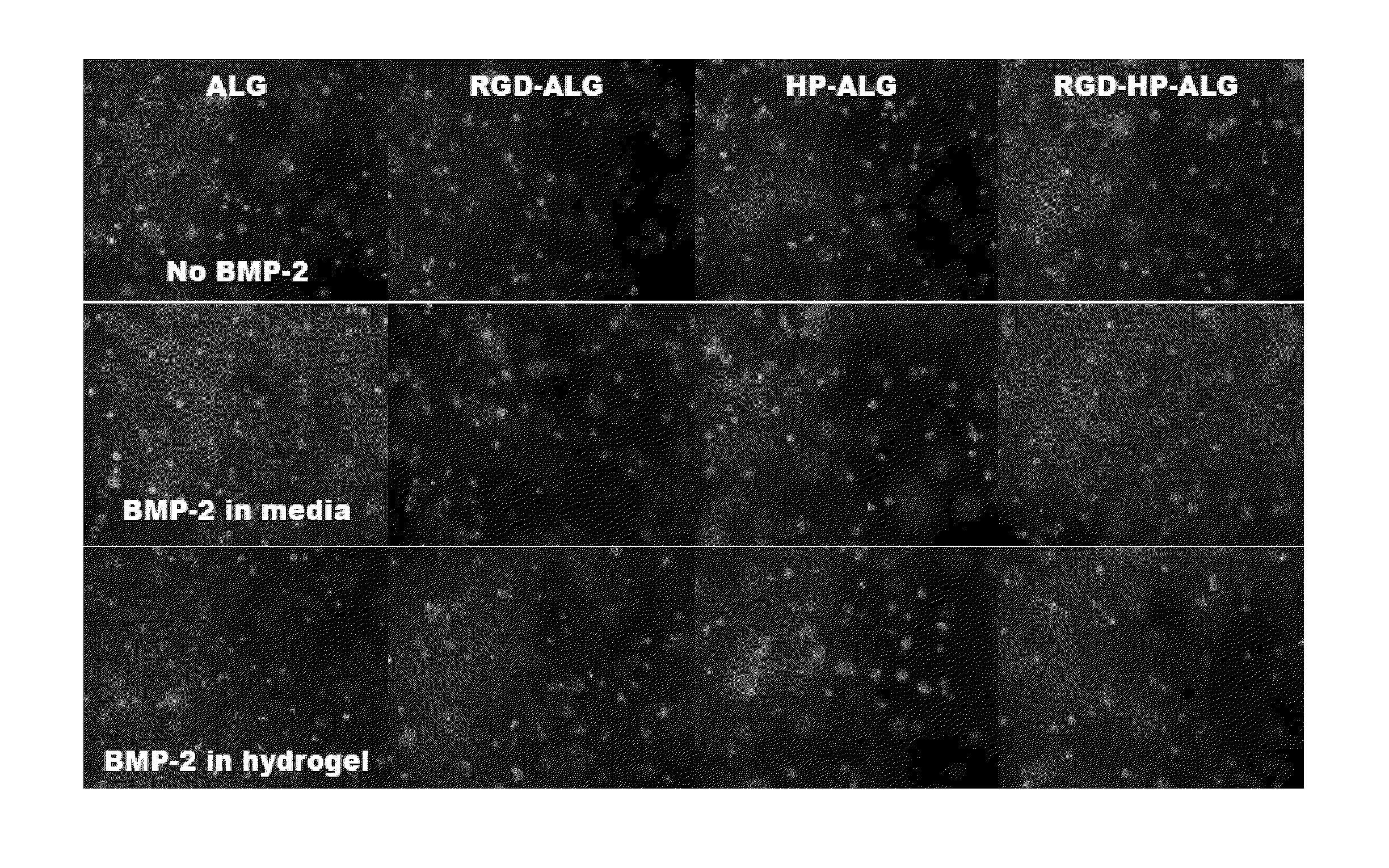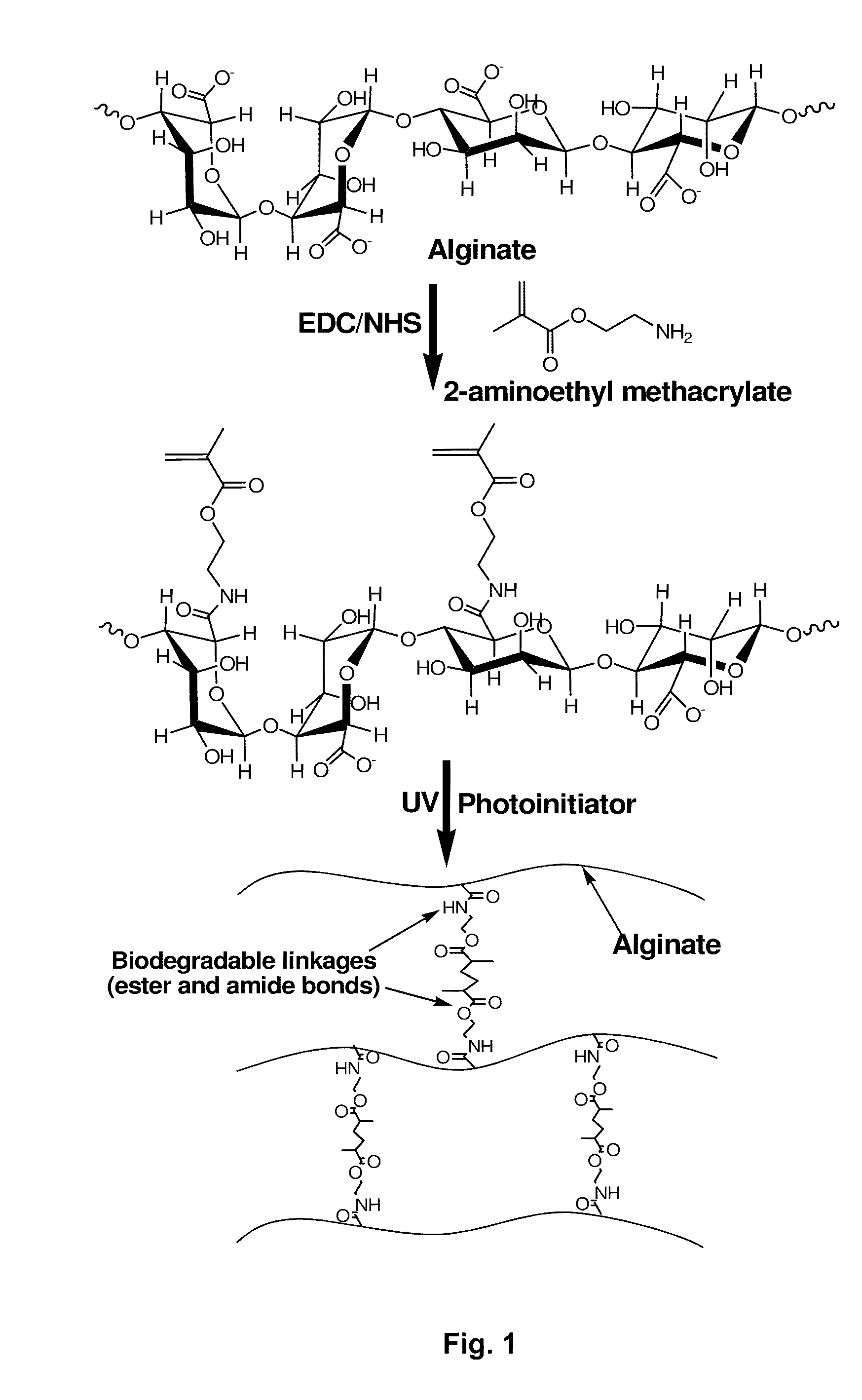Photocrosslinked biodegradable hydrogel
a biodegradable, photocrosslinked technology, applied in the field of tissue engineering, bioactive factor delivery, disease therapeutics, etc., can solve the problems of limited control over the mechanical properties, degradation profiles of ionically cross-linked alginate, swelling ratio, etc., and achieve the effect of reducing the number of encapsulated cells or growth factors, reducing the number of encapsulated cells, and reducing the degradation ra
- Summary
- Abstract
- Description
- Claims
- Application Information
AI Technical Summary
Benefits of technology
Problems solved by technology
Method used
Image
Examples
example 1
Synthesis of Methacrylated Alginate
[0112]The methacrylated alginate was prepared by reacting low molecular weight alginate with 2-aminoethyl methacrylate (AEMA, Sigma, St. Louis, Mo., USA). Low molecular weight of sodium alginate was prepared by irradiating Protanal LF 20 / 40 (FMC Biopolymer, Philadelphia, Pa., USA) at a gamma dose of 5 Mrad / hr for 4 hours. Low molecular weight sodium alginate was dissolved in a buffer solution (1 w / v %, pH 6.5) of 50 mM 2-morpholinoethanesulfonic acid (MES, Sigma) containing 0.5 M NaCl. N-hydroxysuccinimide (NHS, Sigma) and 1-ethyl-3-(3-dimethylaminopropyl)-carbodiimide hydrochloride (EDC, Sigma) (NHS:EDC=1:2) were added to the solution to activate the carboxylic acid groups of the alginate. After 5 min, AEMA was added to the solution. The reaction was maintained at room temperature for 24 hours. After the reaction, the mixture was precipitated by pouring into an excess of acetone, dried under reduced pressure, and rehydrated to a 1% w / v solution in...
example 2
Synthesis of Methacrylated Heparin
[0135]Methacrylated heparin was prepared by reacting heparin (Mw 17000, Sigma, St. Louis, Mo. USA) with 2-aminoethyl methacrylate (AEMA, Sigma) (FIG. 8). To synthesize the methacrylated heparin with methacrylation of two carboxylic acid groups, heparin (1 g) was dissolved in a buffer solution (1% w / v, pH 6.5) of 50 mM 2-morpholinoethanesulfonic acid (MES, Sigma) containing 0.5 M NaCl. NHS (13.8 mg; Sigma) and EDC (45.1 mg; Sigma) (NHS:EDC=1:2) were added to the mixture to activate the carboxylic acid groups of heparin. After 5 min, AEMA (21.7 mg) (molar ratio of NHS:EDC:AEMA=1:2:1) was added to the product. The reaction was maintained at room temperature for 24 hours. After the reaction, the mixture was precipitated by pouring into an excess of acetone, dried under reduced pressure, and rehydrated to a 1% w / v solution in ultrapure deionized water (diH2O) for further purification. The methacrylated heparin was purified by dialysis against diH2O (MWCO...
example 3
Preparation of RGD-Modified Methacrylated Alginate
[0154]RGD-modified methacrylated alginate was synthesized in a two-step reaction utilizing standard carbodiimide chemistry (FIG. 3). Low molecular weight of sodium alginate (37,000 g / mol) was prepared by irradiating Protanal LF 20 / 40 (196,000 g / mol, FMC Biopolymer, Philadelphia, Pa., USA) at a gamma dose of 5 Mrad. Twenty-five percent actual methacrylation of alginate carboxylic groups was performed as described in Jeon, O. et al., Biomaterials 30(14):2724-2734 (May 2009). Methacrylated alginate solutions (1 w / v %) were prepared with 50 mM of 2-(N-morpholino)ethanesulfonic acid hydrate (MES, Sigma, St. Louis, Mo., USA) buffer solution containing 0.5 M NaCl (Sigma) at pH 6.5, and sequentially mixed with N-hydroxysuccinimide (NHS, Sigma) and 1-ethyl-3-[3-(dimethylamino)propyl]carbodiimide (EDC, Sigma). The molar ratio of NHS to EDC was 0.5:1.0, and the weight ratio of EDC to methacrylated alginate was 1.0:20.7. The amino acid peptide s...
PUM
| Property | Measurement | Unit |
|---|---|---|
| diameter | aaaaa | aaaaa |
| diameter | aaaaa | aaaaa |
| diameter | aaaaa | aaaaa |
Abstract
Description
Claims
Application Information
 Login to View More
Login to View More - R&D
- Intellectual Property
- Life Sciences
- Materials
- Tech Scout
- Unparalleled Data Quality
- Higher Quality Content
- 60% Fewer Hallucinations
Browse by: Latest US Patents, China's latest patents, Technical Efficacy Thesaurus, Application Domain, Technology Topic, Popular Technical Reports.
© 2025 PatSnap. All rights reserved.Legal|Privacy policy|Modern Slavery Act Transparency Statement|Sitemap|About US| Contact US: help@patsnap.com



